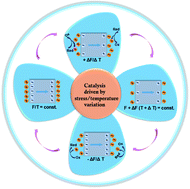Energy and environmental catalysis driven by stress and temperature-variation
Abstract
Effective solutions to the two primary dilemmas of inadequate energy supply and environmental contamination have become a significant focus of researchers for the sustainable development of society and the ecological system. Transforming ubiquitous mechanical force and temperature variation energies into chemical energy by means of the intrinsic characteristics of piezoelectric and pyroelectric nanomaterials is widely considered to be a powerful strategy to counteract the environmental and energy crisis owing to prominent advantages such as the efficient utilization of directional electric charges and enormous source of stress and temperature fluctuation. This review summarizes the advances in energy and environmental catalysis driven by stress and temperature variation based on piezoelectric and pyroelectric effects. Firstly, the internal characteristics of charge carrier separation and transportation of piezoelectric/pyroelectric catalysts in response to external stress and temperature oscillations and the rational mechanisms of piezoelectric/pyroelectric catalysis are elucidated. Then, the catalytic production of renewable fuels (H2 evolution from water splitting and CO2 reduction) and environment remediation (decomposition of organic dyes, mineralization of antibiotics, bacterial inactivation, and removal of heavy metal ions) based on a large number of piezocatalytic and pyrocatalytic catalysts with diverse modification strategies are thoroughly summarized. Finally, the existing challenges and future prospects in this emerging territory are proposed. This comprehensive review is anticipated to offer a powerful reference for the profound research and applications of piezoelectric and pyroelectric materials in the fields of the environment and energy by utilizing ubiquitous mechanical and temperature fluctuation energies.



 Please wait while we load your content...
Please wait while we load your content...